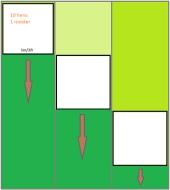Hello world!
I'm Robert, and I humbly ask for your support in creating a Community Centre and a Learning Hub via a sustainable farm for my local community.
I have opened a GoFundMe page where you can read the basics of my project, but I will elaborate further here.
There is quite a lot to go through, so I will post periodically about it in this thread.
Feel free to Ask Me Anything!
So, first of all,
some introductions. I didn't want to go into too much detail on the GFM website, so as not to waste space and keep it compact.
I am 30 years old at the moment of writing this post. Like many fellow Croatians, I left my home in search for a better life, better job, and so on. I had always had an idea of living in the countryside (and for a while I did, when I was a kid, but then my parents moved to the city for a job), and have been looking for ways to make it come true.
I would try out different things, like getting a piece of land from a neighbor and cultivating it, or even guerilla gardening. Those attempts failed for many reasons, including financial and logistic, but I have learned great many things from them.
I realized that for a while conditions would not be met for anything long-term, so I decided to go on a search for knowledge, through books and hands-on approach. I read Fukuoka's
One Straw Revolution, Sir Albert Howard's
The Soil and Health, and many other 'random' books and plethora of articles, posts, videos... I traveled Europe through associations such as WWOOF and EVS (European Volunteer Service), visiting countries like Bulgaria, Belgium, Portugal (I even hitch-hiked to those countries because I couldn't afford to travel there like a normal person), to get experience in growing plants, building with natural materials, exchange ideas.
I studied at the "Faculty of Agrobiotechnical Sciences Osijek" for two years, but didn't complete my studies as I had to work (such was life in Croatia).
All this was great, but I yearned to do something of my own, on my own land, but I realized that it would take me decades to even get to square one with the Croatian standard. I decided to break the cycle and emigrated to Ireland in 2019.
As chance would have it (or Providence, for that matter), the first week I found my first job there as a butcher. I haven't considered that line of work before, but the ad was there on the door of the shop, and I thought this could be a good way to connect the growing of food with processing it. And so it was, I gained invaluable knowledge over the next 3 years, and I am loving every bit of that job (though I haven't yet killed an animal before, but all in due time). I did that until the shop closed down around April 2022.
In March last year, after lots of contemplation, I finally mustered the courage to buy some land in Croatia. It's not a huge lot, as the pandemic left me with not a lot of financial wealth, but I bounced back like I always do, and now I'm going back there to start this project.
The up-side of the pandemic was that it gave me, and many others, time to think. Think about my life, my goals, time to develop a strategy, fortify my knowledge, put together a plan, and now it's all here.
I've spoken to many people, and a lot have the same struggles as myself: they are not happy just grinding out their days and would love to have more free time for themselves, to dedicate it to their hobbies, friends and family (many would like to start a family, but are discouraged by the current state of affairs). I've seen people on youtube escaping the modern world by retreating into remote places, going off-grid, but nice as though time may be, vast majority wouldn't are not prepared to make that move. However, a vast majority
would be willing to just take a step back, and get a mix of the more relaxed countryside life combined with a proximity to the city and the life they're used to. They wouldn't necessarily see themselves farming full-time, but having a few chickens and a patch of veggies together with a regular job for steady income seems plausible for most.
This is where I come into play. With my experience and permaculture's principles, I would help to get the most out of that little patch of land, while also keeping scalability in mind so that those who
would want to do farming full-time can easily do so, and even go further and expand it into an actual business.
Now, just a small plot of land on it's own doesn't get you too far, but when the whole neighborhood comes together, a whole lot more can be achieved - and I believe people can and want to do this, it's just a matter of showing and guiding them, and once it kicks off it will snowball into something quite grand.
That is all for the time being, thanks for sticking with me so far. Tomorrow I will be uploading some plans on how I'm going to start off, and some sketches/blueprints of what the place looks like.
Soon I'll be opening a Facebook page, too, so you'll be able to see a few more on-site sights, and once I actually get started (March 27) you can stay up to date with the whole thing.
So please, head on over to
https://gofund.me/e82dc698 and drop a few cents if you can, literally every little helps, and I'd be more than super thrilled for every penny that finds its way towards the cause.
Thanks!












